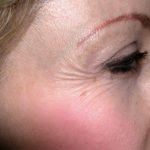Lines around the eyes give a variety of emotional expressions, most of which convey a negative impression. These periocular lines, or crow’s feet as they are commonly referred to, are the result of normal but excessive muscle action of the underlying orbicularis oculi or sphincter muscle of the eye. As wrinkle lines form perpendicular to the action of the encircling muscle around the eye, wrinkles develop and radiate outward in a ‘sunray’ effect. Elimination or softening of these lines is a frequently requested procedure. While this request is simple, adequately treating crow’s feet often requires combination therapy.

For the older patient who at rest already has established crow’s feet wrinkles, combination therapy will be needed. Botox in combination with laser resurfacing can produce some really significant results. Since the eyelids and the surrounding skin is quite thin, it is an area that is particularly reponsive to laser resurfacing. For most patients that have a treatment focused on the crow’s feet area alone, we are not talking about deep laser surfacing. Rather I use a light to moderate depth laser resurfacing so that healing occurs quite quickly, usually within three to five days. Laser depths around 35 to 50 microns (deep laser resurfacing is around 200 – 300 microns) are easily tolerated in the office under topical anesthetic cream, are quick to perform, and require minimal post-treatment care. The crow’s feet area is pre-treated with Botox during the same visit and then laser resurfaced. To keep the recovery quick, the depth of laser penetration is keep limited. Think about a series of these treatments done twice a year to eventually get the best result.
Botox and light laser resurfacing are the principal methods of treatment for crow’s feet. Botox alone is a great treatment for young patients given its prophylactic effects. When laser resurfacing of the crow’s feet skin is needed, a good long-term result is only possible if the underlying muscle action is controlled.
Dr. Barry Eppley
Indianapolis, Indiana


